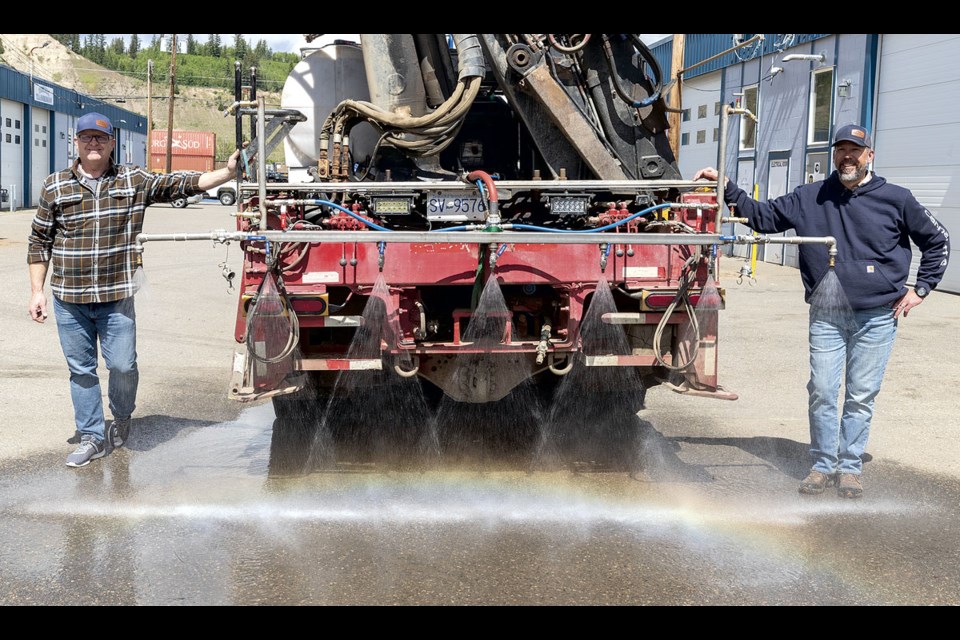A Prince George construction company is pioneering the use of an environmentally friendly method to prevent rail lines from burning in wildfires.
It's a water additive sprayed from a heavy-duty hi-rail truck that runs along the rail lines to protect bridges and other infrastructure.
On May 14, LinkBuild Construction owner Phil Toma got the call to respond to the Crescent Spur wildfire burning near McBride, about 160 kilometres east of Prince George.
It was the first time in a real fire situation that LinkBuild was able to demonstrate the capabilities of FireRein Eco-Gel. The biodegradable vegetable-based substance sticks to wherever it lands and coats even vertical surfaces to act as a fire suppressant and short-term retardant.
Mixed with 95 per cent water, it leaves a thick white goo that swells to retain water and maintain its fire-resistance properties.
LinkBuild sprayed 14 rail trestle bridges threatened by the Crescent Spur fire and none of them caught fire.
That led to a week-long deployment to Fort Nelson the following week and the company worked 17-hour days, spraying rail structures and road bridges close to huge fires that forced the evacuation of the town.
“We sprayed track, sprayed bridges, sprayed accesses and B.C. Wildfire phoned me one night and said, ‘What have you been doing and what have you been spraying?’ and they would love to use the product,” said LinkBuild construction manager Ryan Schuck.
“What we know is no bridges caught fire, no rail lines caught fire. Everybody was able to access all the work up there. It works, and it’s working well.”
The 10-tonne tridem truck carries a 7,500-litre holding tank for the mixture and a 1,000-litre tank that contains the concentrated gel. If the main tank is drained all that’s needed to a water supply to replenish it and keep the truck operational. The gel product costs $10,000 for every 1,000-litre tank.
LinkBuild partnered with Tharrow Crane of Prince George to mount a grapple crane on the back of the truck used to lift storage tanks and remove any trees or other obstructions that might fall on the rail line. The four-person crew also uses a 150-foot hose to apply the mixture to the underside of structures.
The gel contains organic clay that has surfactant qualities, like a detergent, which when added to water reduces surface tension and increases the mixture’s spreading and wetting qualities. It retains its fire retardancy for at least 72 hours.
“It attracts water, so it makes water go farther,” said Schuck. “When we spray it that water stays around because it is being bound in those gels and the organic clay.”
A spreader bar attached to the back of the truck sprays the mixture directly to the rail bed while jets mounted on either side spray beyond the track at a 45-degree angle to create a wider path of fire resistance.
“We’re not doing miles of track,” said LinkBuild Construction owner Phil Toma. “We’re doing 50 feet at either end of the trestle and then 100 feet along the trestle and just letting it drain down and using a hose to spray some timbers that got missed.
“There’s thousands of trestles in northern B.C. A lot of them are steel structures but it’s the approaches they’re concerned about because they’re timbered (wood) approaches.”
As a backup unit, LinkBuild has a hi-rail pickup truck that runs on the rail equipped with a small water tank that draws from 20-litre pail of Eco-Gel.
Schuck said Eco-Gel will seal a creosote-soaked rail tie and prevent off-gassing of flammable hydrocarbons that produce a noticeable smell, especially on hot days. A spark from a train wheel or brakes can ignite that gas in a flash fire that can lead to a wildfire.
Because it is not toxic to the environment, the company sees Eco-Gel as a better alternative to PhosChek, an ammonium phosphate-based chemical mixed with corrosion inhibiters and thickening agents and iron oxide that’s commonly used in BC as the bright-red fire suppressant dropped by aircraft.
“That big fire last year in Kelowna is basically where I grew up and that whole mountain is dead,” said Schuck. “The whole mountain has been covered by salts and ammonium phosphate and they’ve killed everything.
“We have to save our water and save our environment. We want to be part of the solution and not part of the problem.”
The rainy June has slowed business but with summer just beginning this week they are ready to respond to the next call.
The pump and gel tank can easily be detached for helicopter transport to a remote location.
The cost of replacing a mainline rail trestle can easily amount to millions of dollars, and when combined with lost revenue from downtime repairing that bridge that makes structure protection that much more important, said Toma.
Toma says it costs as much as $200,000 to replace one electrical power pole and he’d like to explore the possibility of working with B.C. Hydro to devise a plan on structure protection using Eco-Gel to help save its infrastructure from fire damage.
“This is exciting stuff,” said Toma. “It could make a serious impact. We’re kind of on the cusp of it.”


